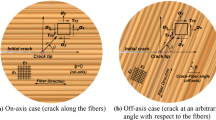Abstract
Brittle fracture mechanisms, characterizing wood behavior, are investigated numerically with the help of the smeared-crack approach combined with a multi-surface plasticity model. Numerical instabilities, accompanying the significant strain-softening behavior, are treated by using both a localization limiter and viscous regularization. In addition, extension of the model to large deformation conditions is proposed based on an objective stress rate using the rotation of wood fibers. Computations are carried out to predict the load carrying capacity and the post-cracking behavior of wood members under compression, bending and buckling, respectively. Competition between the multiple fracture processes is also analyzed from the simulation results.



















Similar content being viewed by others
References
Ashby MF, Easterling K, Harrysson R et al (1985) The fracture and toughness of woods. Proc R Soc Lond A 398:261–280
Bazant ZP, Oh BH (1983) Crack band theory for fracture concrete. Mater Struct 16:155–177
Benabou L (2008) Kink band formation in wood species under compressive loading. Exp Mech 48:647–656
Benabou L (2010) Predictions of compressive strength and kink band orientation for wood species. Mech Mater 42:335–343
Benabou L (2012) Finite Strain analysis of wood species under compressive failure due to kinking. Int J Solids Struct 49:408–419
Benallal A, Billardon R, Lemaître J (1991) Continuum damage mechanics and local approach to fracture: numerical procedures. Comput Methods Appl Mech Eng 92:141–155
Boisse P, Gasser A, Hagege B et al (2005) Analysis of the mechanical behavior of woven fibrous material using virtual tests at the unit cell level. J Mater Sci 40:5955–5962
Crisfield MA (1997) Non-linear finite element analysis of solids and structures, vol. 2., Advanced topicsWiley, New York
Daudeville L (1999) Fracture in spruce: experiment and numerical analysis by linear and non linear fracture mechanics. Holz Roh Werkst 57:425–432
Dourado N, Morel S, de Moura MFSF, Valentin G, Morais J (2008) Comparison of fracture properties of two wood species through cohesive crack simulations. Composites Part A 39:415–427
Duvaut G, Lions JL (1972) Les inéquations en Mécanique et en Physique. Dunod, Paris
Hagege B, Boisse P, Billoet JL (2005) Finite element analyses of knitted composite reinforcement at large strain. Eur J Comput Mech 14:767–776
Hanhijarvi A, Helnwein P, Ranta-Maunus A (2001) Two-dimensional material model for structural analysis of drying wood as viscoelastic-mechanosorptive-plastic material. In: 3rd workshop on Softwood drying to specific end-uses, COST ACTION E15, Espoo, Finland
Hillerborg A, Modeer M, Petersson PE (1976) Analysis of crack formation and crack growth in concrete by means of fracture mechanics and finite elements. Cem Concr Res 6:773–782
Hughes TJR, Winget J (1980) Finite rotation effects in numerical integration of rate constitutive equations arising in large deformation analysis. Int J Numer Methods Eng 15:1862–1867
Loret B, Prevost JH (1990) Dynamic strain localization in elasto-(visco-)plastic solids, part 1. General formulation and one-dimensional examples. Comput Methods Appl Mech Eng 83:247–273
Lucena-Simon J, Kröplin BH, Dill-Langer G et al (2000) A fictitious crack approach for the anisotropic degradation of wood. In: Proceedings of the international conference on wood and wood fiber composites, Stuttgart, pp 229–240
Mackenzie-Helnwein P, Eberhardsteiner J, Mang HA (2003) A multi-surface plasticity model for clear wood and its application to the finite element analysis of structural details. Comput Mech 31:204–218
Ohmenhäuser F, Weihe S, Kröplin B (1999) Algorithmic implementation of a generalized cohesive crack model. Comput Mater Sci 16:294–306
Oliver J (1989) A consistent characteristic length for smeared cracking models. Int J Numer Methods Eng 28:461–474
O’Loinsigh C, Oudjene M, Shotton E, Pizzi A, Fanning P (2012) Mechanical behaviour and 3D stress analysis of multi-layered wooden beams made with welded-through wood dowels. Compos Struct 94:313–321
Perzyna P (1971) Thermodynamic theory of viscoplasticity. Adv Appl Mech 11:313–354
Pietruszczak S, Mroz Z (1981) Finite element analysis of deformation of strain-softening materials. Int J Numer Methods Eng 17:327–334
Poulsen JS, Moran PM, Shih CF et al (1997) Kink band initiation and band broadening in clear wood under compressive loading. Mech Mater 25:67–77
Reiterer A, Tschegg S (2002) The influence of moisture content on the mode I fracture behaviour of sprucewood. J Mater Sci 37:4487–4491
Rots JG, De Borst R (1987) Analysis of mixed-mode fracture in concrete. J Eng Mech-ASCE 113:1739–1758
Saft S, Kaliske M (2011) Numerical simulation of the ductile failure of mechanically and moisture loaded wooden structures. Comput Struct 89:2460–2470
Sandhaas C, Van de Kuilen JW, Blass HJ (2012) Constitutive model for wood based on continuum damage mechanics. In: WCTE 2012, World conference on timber engineering, Auckland
Schmidt J, Kaliske M (2009) Models for numerical failure analysis of wooden structures. Eng Struct 31:571–579
Sih GC, Paris PC, Irwin GR (1965) On cracks in rectilinearly anisotropic bodies. Int J Fract Mech 1:189–203
Simo JC, Kennedy JG, Govindjee S (1988) Non-smooth multisurface plasticity and viscoplasticity: loading/unloading conditions and numerical algorithms. Int J Numer Methods Eng 26:2161–2185
Triboulot P, Jodin P, Pluvinage G (1984) Validity of fracture mechanics concepts applied to wood by finite element calculation. Wood Sci Technol 18:51–58
Vasic S, Smith I, Landis E (2005) Finite element techniques and models for wood fracture mechanics. Wood Sci Technol 39:3–17
Weihe S, Kröplin B, De Borst R (1998) Classification of smeared crack models based on material and structural properties. Int J Solids Struct 35:1289–1308
Xu BH, Bouchaïr A, Taazount M, Vega EJ (2009) Numerical and experimental analysis of multiple-dowel steel-to-timber joints in tension perpendicular to grain. Eng Struct 31:2357–2367
Author information
Authors and Affiliations
Corresponding author
Rights and permissions
About this article
Cite this article
Benabou, L., Sun, Z. Numerical study of anisotropic failure in wood under large deformation. Mater Struct 48, 1977–1993 (2015). https://doi.org/10.1617/s11527-014-0287-6
Received:
Accepted:
Published:
Issue Date:
DOI: https://doi.org/10.1617/s11527-014-0287-6




